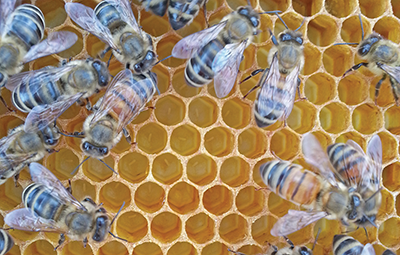
When starting out in beekeeping, it’s really hard to recognize if your colony is doing well. You most likely lack the prior experience to compare what you see going on in your hive now with what a colony should look like at this time of year in your specific region.
While it feels good if you can spot the queen, you don’t actually need to find her: Instead, you should be able to read her handiwork, understanding if she is laying well. To do this, you need to be able to spot eggs. Honey bee eggs are always described as looking similar to a grain of rice. I eat a lot of rice and I’ve never seen such a tiny, skinny elongated grain. Bee eggs, if anything, resemble emaciated grains of rice. If you can’t spot eggs, invest in an inexpensive magnifying glass.
Brood Development
The vast majority of baby bees—what beekeepers call brood—is worker brood in a healthy hive. Workers develop from fertilized eggs laid into cells. After three days, the eggs hatch into larva that look like a tiny white grub curled in a pool of milky white. That glistening white substance is brood food, produced by the nurse bees. The grub eats and eats and eats, fed by nurse bees over 100x per day. After approximately 5.5-6 days, the cell is capped with wax. Underneath that capping, the larva stretches out and spins a cocoon of silk. Inside that silk, the lava pupates, emerging as an adult approximately 12 days later.
Worker development is easy math. Just keep doubling the number: 3 days as an egg + 6 days as a larva + 12 days underneath a capping = 21 days until adult.
Eggs
If you can spot eggs in your hive, you can tell if your colony is “queenright” even if you don’t spot the queen. Queen laid eggs are almost always laid one egg to a cell, with the egg deposited at the base of the cell. (Brand new queens are still getting the hang of egg-laying and will occasionally lay two eggs per cell.) The egg stands erect for about 24 hours, then slowly tips over. When workers lay eggs there will usually be multiple eggs per cell, deposited on the cell wall, as their abdomens are too short to reach the cell bottom. Usually a queen will lay eggs in adjacent cells, filling up a circular patch on a frame. She will only lay eggs in cells that the worker bees have prepared properly, cleaning them of debris and “polishing” them. Whenever you spot eggs on a frame, be extra careful handling that comb as it is not unusual for the queen to be found on a frame with newly laid eggs.
Larvae
After three days, the eggs hatch into tiny larvae. At first they are not much bigger than the egg, a tiny c-shaped white grub barely visible at the bottom of the cell. The young larvae float in a pool of brood food, a shiny translucent pearly substance that looks a little like egg white just as it starts to cook. Beekeepers sometimes refer to this brood food as “bee milk” as it is a nutritionally rich substance the nurse bees make after consuming protein rich pollen.
Larvae have one simple tasks in life. Eat, eat, and eat some more to grow as rapidly as possible. A larva doubles in size up to 1,500 times during the six days of development. A larva molts five times, growing substantially in size after each molt. These larval stages are called ….


